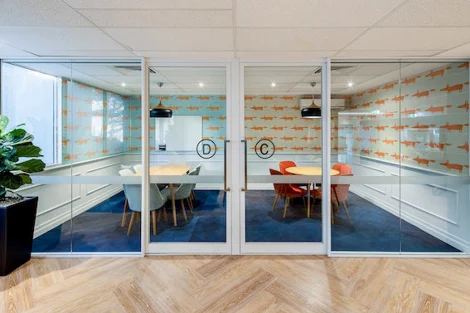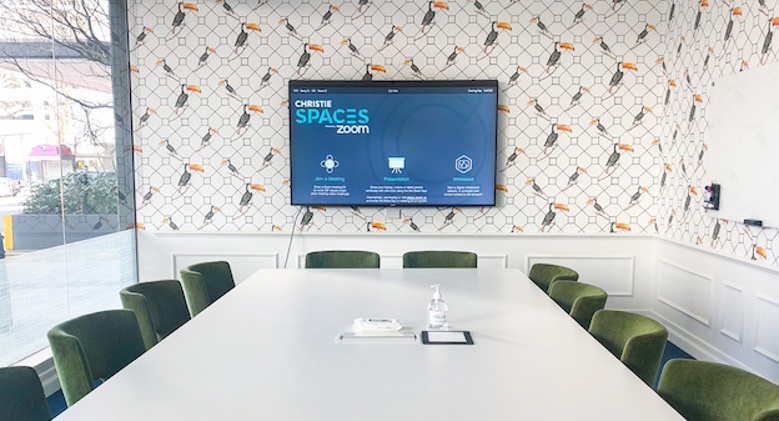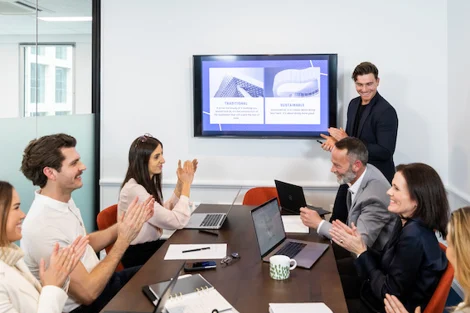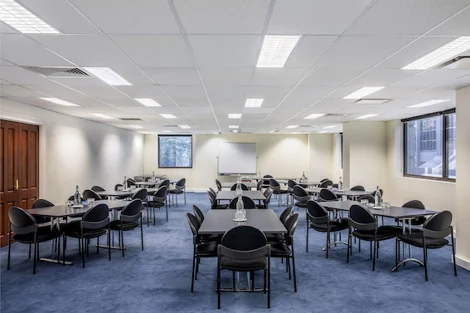
Can the Design of a Meeting Room Affect your Productivity?
SHARE

Meeting and training rooms are essential of the modern workplace to encourage higher levels of employee collaboration— the use of meeting rooms helps with the sharing of ideas, research and expertise between teams. On the other hand, when you have ill-functioning equipment or an unorganised space, meetings can become more frustrating and unproductive.
The modern employee spends a huge amount of time in meetings. A Harvard Business Review survey found that the average executive in today’s world spends a massive 23 hours per week in meetings. That’s a big jump from the average of 10 hours per week during the 1960s.
Of course, spending more time in meetings is not a problem in and of itself. But when meetings are not achieving what they are designed to, or if they are doing so too slowly, then is when it begins to impact productivity and employee satisfaction. Of those executives surveyed, 71% considered their meetings to be unproductive or inefficient, 62% said their meetings did not work to induce collaboration, and 64% said their meetings came at the expense of deep thinking.
The knee-jerk reaction might be to halt the meetings and get people back at their desks. But there is enough evidence to suggest that this would mean also denying the positive aspects of having regular meetings. So, the key is not to get rid of meetings altogether but to do meetings better.
There are a number of ways in which a meeting can be improved, but one of the most critical ones is the setup of the room itself. So, how can a meeting room be set up better to improve productivity?
The Tech
First things first: You need to have the correct gear, and it has to work effectively.
We’ve all had experiences of turning up to a meeting and the host having trouble working the equipment. While everyone has had enough time to learn how to load a presentation, get the speakers working, and get connected on a Zoom call – sometimes it’s just a technical fault that can disrupt your meeting.
To avoid anyone struggling to begin or continue, the room setup needs to have the right tech in place and be easy to use before it even starts.
To cover the basics, you’ll need:
- A screen for presentations
- The right cables to connect the screen to any make of laptop
- An effective sound system
- Virtual meeting room software (Zoom etc.)
- Presentation software (PowerPoint etc.)
Using multimedia can actively boost the engagement of participants in meetings produces more valuable outcomes, keeps your participants more engaged and helps convey information in more easily digestible forms. To achieve this you need high-definition working screens and presentation software.
The Seating
Not all meetings are the same. Some are centred around presentations, some around whole-group discussions, some around micro-discussions, and most are a mixture.
The design of the meeting room needs to reflect the specific dynamics and outcomes of each meeting it is used for. It also needs to be able to be easily adapted to multiple functionalities within one meeting time slot.
To make this happen easily, a good meeting room needs to be equipped with seating and desking that is capable of being configured in multiple setups. This allows for quick shifts between workflows and allows a single meeting to fulfil multiple functionalities.
Less is more: if you can condense two or three meetings into one, productivity will rise.
The types of seating and desking setups you might want to shift between will include:
- A roundtable setup for whole-group discussion
- A seminar setup for presentations
- A cabaret setup for pairs to work on activities
- A grouped-desks setup for multiple micro-meetings
It’s essential that the furniture you use in your meeting rooms can be moved easily so that time isn’t wasted playing boardroom Tetris.
Also, as with the presentations, don’t let form get in the way of function. Only reconfigure the room mid-meeting if it is actually going to contribute to better results. Making everyone get up and move the desks and chairs into a cabaret set-up so that team members can carry out a five-minute paired activity probably isn’t productive, even if the whole operation feels like teamwork.
Meeting Rooms on the Fly
The final thing to consider is how your meeting room fits in with the rest of your office. Time can be wasted getting the team to a meeting room. During the migration, one or two stragglers might find the need to duck to the bathroom, and by the time the room has been configured and a presentation set up, fifteen minutes may have passed.
For this reason, you should consider having some sections of your workspace set up so that they can be transformed into meeting rooms on the fly. For example, if you lease a Christie Spaces project space, you can customise it by doubling a hot-desking zone as an ad-hoc meeting space. You could do this by having a wall-mounted presentation screen within the hot-desking zone, so that you can spontaneously shift between individual work and team meetings, without having to go through the rigmarole of setting up a new space.
Once you’ve got the bare mechanics of your meeting room layout down, you can start instituting procedural changes to make your meetings more productive. Think of things like setting hard time limits, using agendas, detailing meeting outcomes and using strategies to include all team members.
Of course, you can also take a leaf out of Elon Musk’s productivity playbook and start walking out of meetings that are being unproductive or inefficient. This might not be something you want to do literally, but you get the point.
Make sure to maximise your meeting room space and, in turn enhance the productivity of your meetings.
Related articles


The Five Essentials to Hosting an Effective Meeting


